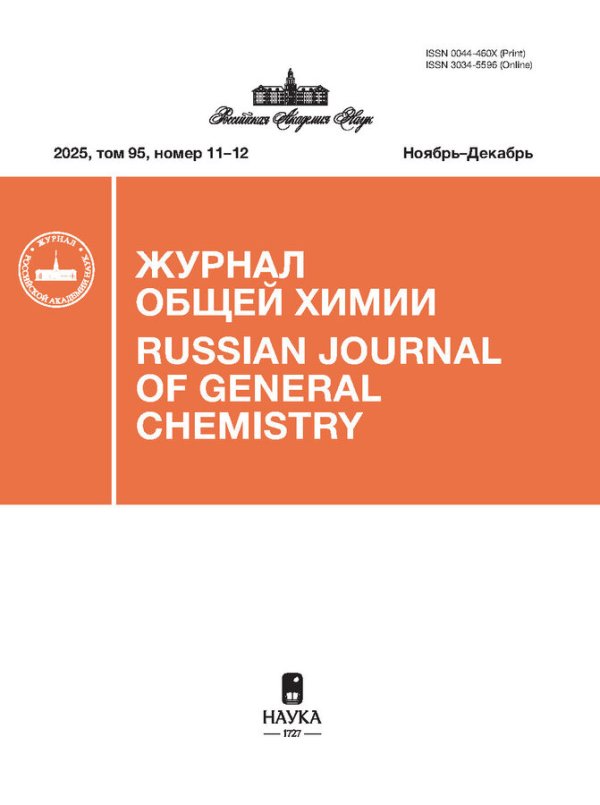Vol 94, No 2 (2024)
Articles
Method for Synthesis of 4-(4-Hydroxyphenyl)cycloalkanedicarboxylic Acids Based on SEAr Alkylation
Abstract
A study was carried out on the alkylation reaction of anisole with cycloalkenedicarboxylic acids in the presence of various catalytic systems. It was found that the reaction proceeds with high yields in the presence of aluminum chloride, ferric chloride, and p-toluenesulfonic acid. The possibility of further cleavage of the ether bond to obtain 4-(4-hydroxyphenyl)cycloalkanedicarboxylic acids was demonstrated. The resulting compounds are potential biologically active compounds.
 167-173
167-173


Synthesis of Disecondary Aromatic Diols
Abstract
The synthesis of disecondary aromatic diols (the main precursors for divinyl aromatic monomers) was carried out. The optimal conditions for the preparation of these diols by selective catalytic hydrogenation of aromatic diketones in the presence of Raney nickel and by reduction of these diketones by sodium borohydride were established. It was demonstrated that sodium borohydride reduction afforded the pure diols under mild and relatively safe conditions (in the systems of CHCl3–PEG400–H2O, at room temperature and atmospheric pressure).
 174-184
174-184


Transformation of 2,2-Di(3-nitro-4-chlorophenyl)-1,1,1-trichloroethane in the Alkali–Amide Solvent Medium
Abstract
A quantum chemical analysis of the transformation pathways of 2,2-di(3-nitro-4-chlorophenyl)-1,1,1-trichloroethane in NaOH–DMF, involving competing reagents, was performed. For each reaction, spatial structures were modeled and the energy parameters of the pre-reaction, activated and post-reaction complexes were calculated. As a result of the analysis of the thermodynamic parameters of the reactions, the most energetically favorable scheme for the transformation of 2,2-di(3-nitro-4-chlorophenyl)-1,1,1-trichloroethane into 2,2-di(3-nitro-4-N,N-dimethylaminophenyl)-1,1-dichloroethene was proposed. The mechanisms of the occurring reactions were established.
 185-193
185-193


Synthesis of 5-[(Alkylsulfanyl)methyl]-1,3-dioxanes from 3-[(Alkylsulfanyl)methyl]pentane-2,4-diols
Abstract
Heterocyclization of 3-[(alkylsulfanyl)methyl]pentane-2,4-diols with formaldehyde or propionaldehyde in boiling benzene in the presence of hydrochloric acid afforded new 5-[(alkylsulfanyl)methyl]-4,6-dimethyl-1,3-dioxanes. 1,3-Dioxanes are formed as a mixture of 4,6-cis- and 4,6-trans-isomers at a ratio of 1:0.3–0.9. In both isomers, the preferred chair conformation is realized. In the 4,6-cis-isomers of all 1,3-dioxanes, the methyl groups occupy a diequatorial position, and the alkylsulfanylmethyl substituent is in an axial orientation. In the 4,6-cis-isomer of 5-[(pentylsulfanyl)methyl]-2-ethyl-1,3-dioxane, the ethyl group is oriented equatorially. The 4,6-trans-isomers of 5-[(alkylsulfanyl)methyl]-1,3-dioxanes are characterized by a rapid conformational inversion chair–chair.
 194-202
194-202


 203-208
203-208


A New Approach to the Synthesis of [1,2,4]Triazolo[1,5-a]pyrimidines by Reaction of 1,2,4,5-Tetrazines with 2-Aminoxazoles
Abstract
A new transformation of 3,6-diphenyl-1,2,4,5-tetrazine was discovered during the solvent-free reaction with 2-amino-4-aryloxazoles, leading to the formation of 2,5,7-triaryl[1,2,4]triazolo[1,5-a]pyrimidines. Stucture of products was also confirmed by single crystal X-ray diffraction data. A possible mechanism for this reaction was proposed.
 209-215
209-215


Electron Transfer in Reaction of 12H-Quinoxalino[2,3-b]phenoxazines with π-Acceptors
Abstract
Using the reaction of 2,4-di-(tert-butyl)-12-(4-methoxyphenyl)-10-methoxy-12H-quinoxalino[2,3-b]phenoxazine with π-electron acceptors such as tetracyanoquinodimethane and 3,6-di-(tert-butyl)-o-quinone) as an example it was shown that derivatives of this N,O-pentaheterocyclic system are effective electron donors that, under mild conditions, carry out electron transfer reactions with the formation of stable cation and anion radical structures.
 216-224
216-224


Novel Catalytic Systems for Condensation of Monoterpene Compounds with Aldehydes (A Review)
Abstract
New catalysts for the Prins condensation of renewable monoterpene compounds with aldehydes were considered. Effective catalytic systems were functionalized zeolites, oxides, clays, halloysite and carbon nanotubes, organometallic structures and heteropolyacids, which make it possible to obtain target products with high selectivity. A number of compounds synthesized using such systems are used in perfumery, have high pharmaceutical potential and are platform molecules for further synthesis.
 225-244
225-244


Effect of the Nature of Nitrogen-Containing Organic Base on Destruction of Octa(4-tert-butylphenyl)tetrapyrazinoporphyrazine
Abstract
The properties of octa(4-tert-butylphenyl)tetrapyrazinoporphyrazine in 2-methylpyridine were studied. During the acid-base interaction of molecules, a kinetically stable complex was formed with proton transfer. The addition of morpholine, piperidine, n-butylamine, and diethylamine to 2-methylpyridine led to the destruction of this complex, unlike the addition of tert-butylamine and triethylamine. The influence of the proton-accepting ability and spatial structure of the nitrogen-containing base, as well as the basicity of the medium, on the process of the tetrapyrazinoporphyrazine macrocycle decomposition was considered, and a destruction scheme was proposed.
 245-252
245-252


Gibbs Energy of Cryptand[2.2.2] Transfer from Water to Aqueous Dimethyl Sulfoxide Solvent
Abstract
We represent the Gibbs energies of cryptand[2.2.2] transfer from water to different composition water–dimethyl sulfoxide solvent. The Gibbs energies were determined by interphase distribution of cryptand[2.2.2] between two immiscible solvents. We conclude, that when the dimethyl sulfoxide concentration increases, the cryptand[2.2.2] solvation is weakening.
 253-260
253-260


Chemical Composition and Properties of Water-Methanol Solution of Formaldehyde
Abstract
By reacting paraform with methanol and water at concentrations of 10.8, 11.6 and 22.7 mol/l in the presence of catalytic quantities of monoethanolamine, a method was developed for obtaining a bactericide that, at a concentration of 500 mg/l, completely inhibits the formation of hydrogen sulfide in an accumulative culture of planktonic form of sulfate-reducing bacteria with a quantity of 106 cells/ml. The composition of the resulting bactericide, its effectiveness and corrosion properties were studied. Using scanning electron microscopy using a system for energy-dispersive microanalysis, it was shown that the corrosion products formed during the corrosive action of the bactericide on St-20 steel are iron oxides.
 261-266
261-266


Inclusion Complex of Gd(III) with β-Cyclodextrin and L-Tryptophan
Abstract
An inclusion complex of gadolinium(III) with L-tryptophan (Trp) and β-cyclodextrin (β-CD) with the composition Gd(Trp)3Cl3∙3β-CD∙nH2O was synthesized. It was established that the complex is formed due to the entry of the aromatic part of the L-Trp molecule into the β-CD cavity, and the Gd3+ ions are located in the outer sphere.
 267-274
267-274


Structural Features of d2-Rhenium(V) Monomeric Octahedral Dioxocomplexes with Tridentate-Chelate, Monodentate Ligands [ReO2(Ltri)(Lmono)], and Tetradentate-Chelate Ligands [ReO2(Ltetra)] (A Review)
Abstract
Molecular geometry features of 21 structurally characterized mononuclear octahedral dioxocomplexes of d2-rhenium(V) with mono-, tri- and tetradentate ligands [ReO2(Ltri)(Lmono)], [ReO2(Ltetra)] are discussed. In eleven cases, multiple-bonded Ooxo ligands are arranged in trans-positions to each other with OoxoReOoxo angles ranging within 172.9–180°. In ten structures, the ReO2 unit adopts cis-configuration with OoxoReOoxo angles vary within 106.7–124.8°. Re atoms possess either trans-octahedral coordination environment ReOoxo2X4 (X = N, P, As, O) or cis-structure ReOoxo2N2O2. Bonds Re=Ooxo in monomeric octahedral dioxocompounds d2-Re(V) (mean length 1.772 Å) are significantly longer those observed for monooxocomplexes d2-Re(V) (1.676–1.699 Å).
 275-284
275-284


Synthesis and Structure of Barium Hexaferrite BaFe12–xInxO19 (x = 0–1)
Abstract
This study presents the results of the synthesis and examination of indium-substituted barium hexaferrite samples with the formula BaFe12–xInxO19. The ferrites were obtained via a solid state synthesis method. The substitution level of indium, represented by x(In), was varied from 0 to 1 in 0.25 increments. The stoichiometric formulas of the compounds were calculated using the EDS data. The powder X-ray diffraction analysis indicated that all samples form a single crystalline phase with the M-type hexaferrite structure. Parameters of the crystal unit cell were calculated from powder diffraction data. An expansion of the crystal lattice parameters was observed as iron was substituted with indium, from x = 0 to x = 0.84. The Curie temperatures of the synthesized ferrites were determined using differential scanning calorimetry (DSC) method. It is established that the Curie temperature decreases from 452 to 292°C with In content growth from x = 0 to x = 0.84 in the BaFe12–xInxO19.
 285-291
285-291


Self-Propagating High Temperature Synthesis of Composite Material Based on Zirconium and Chromum Oxide
Abstract
Ceramic composite materials based on stabilized zirconium oxide were obtained by self-propagating high-temperature synthesis. Yttrium oxide was used as a stabilizing additive. The work studied the effect of the content of yttrium oxide additive on the temperature and combustion rate of the materials studied. Also, based on the results of X-ray phase analysis and scanning electron microscopy, the effect of yttrium oxide on the phase composition and microstructure of the synthesized materials was studied.
 292-300
292-300


Heterogeneous Processes in Detoxification of Metal Ions
Abstract
The conditions for the synthesis of sparingly soluble salts of lead, cadmium, mercury(II), copper(II) and iron(II, III) with anions of some organic acids HmL were given. Based on their solubility data (ionic strength I = 0.1), the solubility constants KS were calculated; based on the [Mn+]/MPCM ratio, conclusions were drawn about the applicability of low-toxic organic ligands as precipitators (antidotes) of toxic metal ions. It was shown that deactivation is also possible during the redox reaction of mercury(II), copper(II) with ascorbic acid. According to adsorption data on activated carbon, a number of ions were established to reduce sorption (deactivation ability): Pb2+ (96.6%), Fe3+ (95.4%), Hg2+ (80.6%), Cd2+ (42.4%). Adsorption data complemented the results of reagent methods for studying the detoxification of metal ions.
 301-312
301-312












